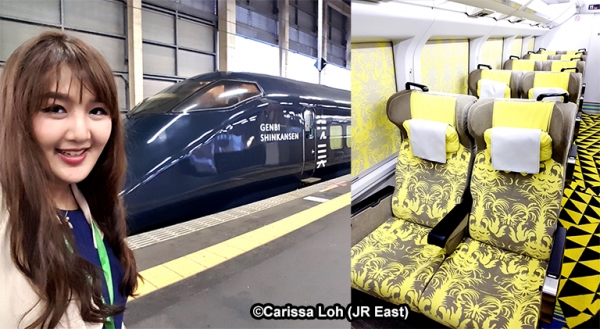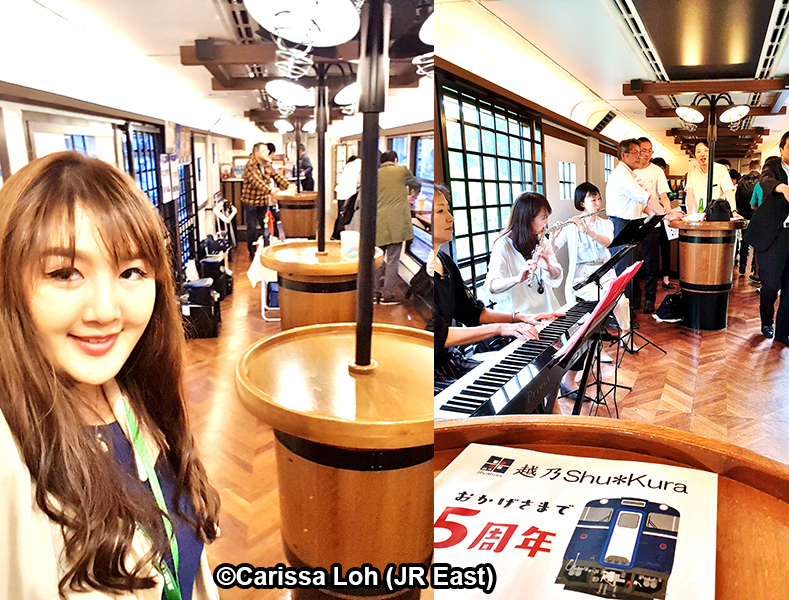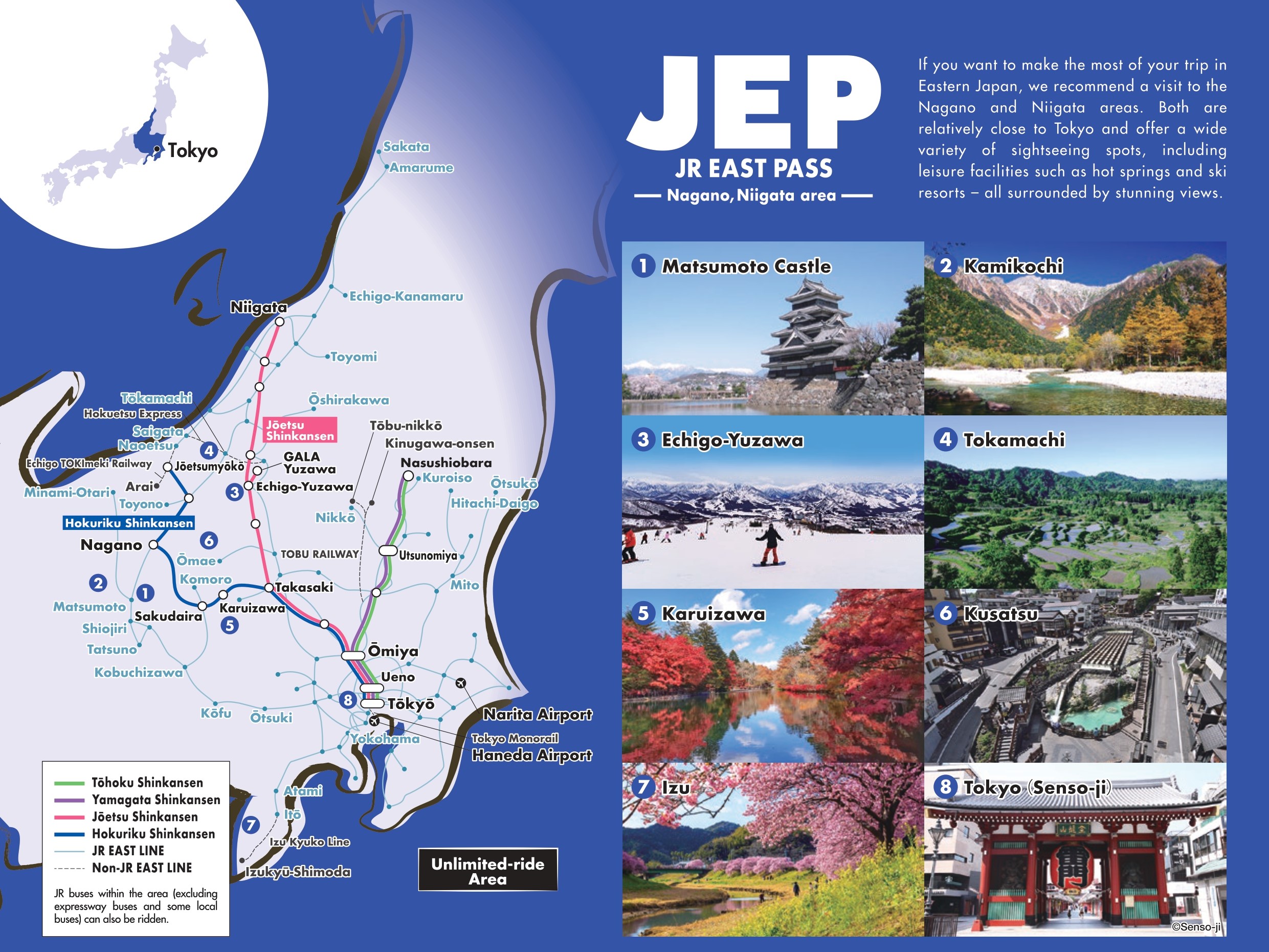The world's fastest art gallery: GENBI SHINKANSEN

NOTE: The GENBI SHINKANSEN permanently ceased operations from December 2020.
Dubbed the “world’s fastest art gallery”, the GENBI SHINKANSEN (現美新幹線) is a bullet train decked out with specially created artworks by contemporary Japanese artists. With fantastic and colourful designs on both its exterior and interior, the impressive GENBI SHINKANSEN is bound to delight riders both young and old! Running at a maximum speed of 240km/h, an entire trip from Echigo-Yuzawa to Niigata takes only one hour, and there are three trains in each direction per day, making this one of the easier Joyful Trains to ride.
For the uninitiated, Joyful Trains are wonderful-themed trains that make a trip out of the train ride. They can come in the form of interior decorations, onboard experiences, station experiences, beautiful scenery, delicious local food and more! The GENBI SHINKANSEN falls within the interior decorations category, with its vibrant and unique artwork installations. (If you are interested in riding other Joyful Trains, check out my other articles on the Toreiyu Tsubasa, POKÉMON with YOU Train, Resort Shirakami, FruiTea Fukushima, TOHOKU EMOTION, HIGH RAIL 1375 and KAIRI.)
Car 11: Nao Matsumoto

Colourful yellow seats of Car 11. (Image credit: JR East / Carissa Loh)
The name GENBI comes from an abbreviation of gendai bijutsu (現代美術 contemporary art). Starting with Car 11, each of the six cars features artwork by different contemporary Japanese artists, commissioned especially for the train. Car 11 is the only car with reserved seats, and the design of the seat covers was conceived by artist Nao Matsumoto. Compared to regular train seats, the seats of the GENBI SHINKANSEN are much more stylish and colourful, and very unlike any other that I have seen. The yellow represents light and bountiful harvests (Niigata is famous for quality rice), and just looking at it brightens my mood. The shade of yellow does look like the colour of rice fields ready for harvest!
Car 12: Yusuke Komuta

Steel artwork in Car 12. (Image credit: JR East / Carissa Loh)
Next up is Car 12, which features a reflective stainless steel installation by Yusuke Komuta. This is probably the favourite car of most of the younger riders, due to the variety of fun photos you can take with the textured metal wall. From this car onward, all seats are non-reserved and free seating. You can sit wherever you want, and are free to move around the train. With comfortable sofas arranged facing the artwork and in angles to encourage conversation, a trip on the GENBI SHINKANSEN is built for you to enjoy with your family and friends.
Car 13: Playroom and café

Playroom with plastic train models. (Image credit: JR East / Carissa Loh)
Car 13 is split into two halves, with the first half being a play space for children. There are plastic train models (including one of the GENBI SHINKANSEN) and tracks for your little ones to play with, and the map-like patterns and mountain-like protrusions on the wall are sure to grab their attention. Having this car on board is a great reason to turn a trip on the GENBI SHINKANSEN into a family outing, and is a fun way to get children interested in art at an early age. There is also a dedicated staff on duty to keep an eye on the children.

Gallery café in Car 13. (Image credit: JR East / Carissa Loh)
The second half of Car 13 is the gallery café. Here you can purchase Tsubame coffee (drip coffee from Niigata’s Tsubame region) served in limited edition GENBI SHINKANSEN cups. There are also some desserts made with local Niigata ingredients for sale, like a cake made with rice flour from Uonuma and butter from Sado Island. The floor and furniture are wooden, and kaleidoscopic abstract paintings by Kentaro Kobuke grace the walls.
Car 14: Naoki Ishikawa

Photographs in Car 14. (Image credit: JR East / Carissa Loh)
Car 14 showcases framed images from photographer Naoki Ishikawa’s journey up the world’s second-highest mountain – the K2 in Pakistan's Karakoram mountain range. Be awed by his photos of the majestic views of rock and snow up to the 8,611m summit. K2 has a reputation for being the deadliest of the five highest mountains in the world – for every four people who reach the summit, approximately one person dies. Making it to the top is already no easy feat; making it and coming back with stunning photos is even more amazing.
Car 15: Haruka Koujin

Haruka Koujin’s colourful artwork in Car 15. (Image credit: JR East / Carissa Loh)
Probably the most striking piece on board, Car 15’s elegant floral installation by Haruka Koujin features numerous colourful little pieces of translucent plastic suspended by threads. As the train moves, the plastic pieces rotate and shift, slowly evolving into new designs over time. Come back after a few minutes to enjoy a different artwork! This unique mechanism works well with a moving train, and isn’t something you can easily enjoy on land, is it?
Car 16: AKI INOMATA

Video installations in Car 16. (Image credit: JR East / Carissa Loh)
The final car, Car 16, houses the train’s newest exhibit, which debuted in July 2018. It is a video installation by artist AKI INOMATA, whose art focuses on collaboration with living creatures, showing that the process of "making" is not exclusive to humans. Her artwork on the GENBI SHINKANSEN focuses on homes, showing hermit crabs with 3D printed shells that she crafted, and juxtaposing with the scenery of beautiful Niigata mountain villages.
Exterior: Mika Ninagawa

Exterior of GENBI SHINKANSEN. (Image credit: JR East / Carissa Loh)
Personally, I feel that the most eye-catching of all is the exterior of the GENBI SHINKANSEN, which is like no other bullet train around. It was designed by renowned artist Mika Ninagawa, and depicts the dazzling fireworks displays of the mesmerising Nagaoka Fireworks Festival – one of Japan’s top fireworks festivals. Moved after my trip on the GENBI SHINKANSEN, I went to see this fireworks festival last year, and it did not disappoint. Click here to read my article on the experience!
Pairing with other Joyful Trains
If you are a fan of trains, how about riding another one? The Koshino Shu*Kura, a sake-themed train, makes a good connection with the GENBI SHINKANSEN at JR Nagaoka Station.

The Koshino Shu*Kura. (Image credit: JR East / Carissa Loh)
Featuring an interior resembling sake caskets at a brewery, enjoy fun activities like sake tasting and live jazz performances! Here are some sample itineraries:
Depart from Echigo-Yuzawa, arrive at Nagano.
Morning | Brewery tour, ponshukan at Echigo-Yuzawa
15:20–15:45 | GENBI SHINKANSEN (Echigo-Yuzawa → Nagaoka)
16:13–18:38 | Koshino Shu*Kura (Nagaoka → Joetsu-myoko)
From Joetsu-myoko, you can take the Hokuriku Shinkansen to Nagano. (20 minutes)
Depart from Niigata, arrive at Nagano.
Morning | Brewery tour, ponshukan at Niigata
14:02–14:25 | GENBI SHINKANSEN (Niigata → Nagaoka)
16:13–18:38 | Koshino Shu*Kura (Nagaoka → Joetsu-myoko)
From Joetsu-myoko, you can take the Hokuriku Shinkansen to Nagano. (20 minutes)
Depart from Nagano, arrive at Niigata.
From Nagano, you can take the Hokuriku Shinkansen to Joetsu-myoko. (20 minutes)
10:02–11:33 | Koshino Shu*Kura (Joetsu-myoko → Nagaoka)
13:14–13:38 | GENBI SHINKANSEN (Nagaoka → Niigata)
Afternoon | Ponshukan, brewery tour, explore Niigata City
Depart from Nagano, arrive at Echigo-Yuzawa or Tokyo.
From Nagano, you can take the Hokuriku Shinkansen to Joetsu-myoko. (20 minutes)
10:02–11:33 | Koshino Shu*Kura (Joetsu-myoko → Nagaoka)
11:54–12:20 | GENBI SHINKANSEN (Nagaoka → Echigo-Yuzawa)
Afternoon | Ponshukan, brewery tour at Echigo-Yuzawa
From Echigo-Yuzawa, you can take the Joetsu Shinkansen to Tokyo. (80 minutes)
Getting there
If you are heading to Niigata and travelling on a weekend, I highly recommend taking the GENBI SHINKENSEN. Why ride a regular bullet train when you can ride this beautifully designed one?
Running mostly on weekends and Japanese public holidays, the GENBI SHINKANSEN makes three round trips per day between JR Echigo-Yuzawa Station (越後湯沢駅) and JR Niigata Station (新潟駅). Check out the timetable and schedule here.
The GENBI SHINKANSEN can be accessed from JR Echigo-Yuzawa Station, which is 80 minutes by bullet train from Tokyo. Unlike other Joyful Trains, this can be ridden without a seat reservation (sofa seats). Alternatively, if you would like to secure a reserved seat (Car 11’s yellow seats), you can make an online reservation here.

JR EAST PASS (Nagano, Niigata area) and usage area. (Image credit: JR East)
In addition, if you are thinking of riding the GENBI SHINKANSEN or visiting the rest of Niigata Prefecture, check out the JR EAST PASS (Nagano, Niigata area), an affordable pass offering unlimited rail travel on JR East lines (including bullet trains) in the valid area for 5 consecutive days at only ¥27,000. You can also make seat reservations for bullet trains, some limited express trains and Joyful Trains online for free, up to 1 month in advance, on the JR-EAST Train Reservation.

The JR-EAST Train Reservation. (Image credit: JR East)
Header image credit: JR East / Carissa Loh




